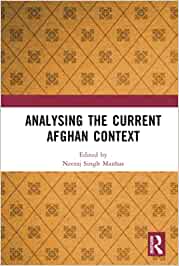World Geostrategic Insights interviews Neeraj Singh Manhas on why China has abandoned its “zero Covid” strategy, the impact of China’s decision globally, and whether Beijing’s “zero Covid” reversal opens a new front of confrontation between China and the West.
 Neeraj Singh Manhas is the Director of Research in the Indo-Pacific Consortium at Raisina House, New Delhi. He has authored three books and has various research interests covering Sino-Indian border issues, China in the Indian Ocean; India-China Foreign Policy; Water security; Defence and Indo-Pacific studies. His recently edited book is “Analysing the Current Afghan Context” (Routledge 2022).
Neeraj Singh Manhas is the Director of Research in the Indo-Pacific Consortium at Raisina House, New Delhi. He has authored three books and has various research interests covering Sino-Indian border issues, China in the Indian Ocean; India-China Foreign Policy; Water security; Defence and Indo-Pacific studies. His recently edited book is “Analysing the Current Afghan Context” (Routledge 2022).
– In recent weeks, the Chinese government has changed its response to COVID-19 prevention and control by implementing a major reversal in its “zero Covid” policy through a significant loosening of health restrictions. The management of COVID-19 was downgraded from Class A to Class B infectious diseases, restoring passport and visa issuance and relaxing border entry policies starting January 8, 2023. The Chinese name of the disease was also changed from new coronavirus pneumonia to new coronavirus infection. Mao Ning, spokesman for China’s Ministry of Foreign Affairs, said, “We are adapting our response measures to COVID-19 to new epidemic developments, so as to better coordinate epidemic response and socio-economic development. We believe that with the united efforts and solidarity of the Chinese people, a new phase of stable and orderly economic and social development will open.” Beyond the official statements, why in your opinion has China abandoned the zero Covid strategy? Was it a forced move to try to revive economic growth? Or was it due to pressure from the growing domestic popular protest against pandemic management and restrictions?
In 2022, China and its leader, Xi Jinping, succeeded as he began his third term with a promise to restore greatness. China had its worst year under Xi’s rule as it reeled from his costly zero-Covid policy, from months of overenthusiastic enforcement that crushed the economy as well as stoked historic popular outrage, to a wholesale abandonment as such sudden and unexpected that left a fragile health system desperately trying to cope with an explosion of cases. Now, nearly three years later, China is one step closer to reopening by relaxing its Covid-19 contingency plan. I think there are various factors and circumstances that contributed to this surprising conclusion.
In 2021, firms such as China Evergrande Group, one of China’s major property developers, defaulted on their interest payments, causing the entire sector to crash. By June 2022, the situation had deteriorated: sales and home prices had fallen, development had stalled, property loan growth had slowed, and consumer confidence had diminished. Despite hints of market stabilisation, protests erupted across the country in response to the mortgage and banking crises.
In July 2022, videos of tanks driving into Henan streets surfaced online, with many posts recalling the Tiananmen Square Massacre. The tragedy has thrown China’s banking system into disarray, preventing individuals from accessing their savings.
In October 2022, during the Party Congress in Beijing, Xi committed to “resolutely fight against all comments and activities that distort, doubt, or contradict” the zero-COVID-19 policy and defended the policy in the congress.
Another risk for Xi Jinping’s regime was that public sorrow could turn into additional protests. All of this has resulted in the administration quickly altering course after grossly underestimating public outrage at their Covid initiatives. The recent clash at the world’s largest iPhone assembly facility in Zhengzhou, where thousands of Foxconn Technology Group employees clashed with police in violent demonstrations aimed in part at pandemic limits.
The death of former leader Jiang Zemin in November increased pressure on the administration. Many people look back on his time as a time of reconnecting with the outside world and rapid growth. The parallels with the current scenario are striking.
Indeed, the prolonged lockdowns have harmed China’s economy, which was already undermined by the ongoing repercussions of the US trade war; deleveraging effects, particularly in the property sector; and collateral damage from the Russia-Ukraine war. Recognizing the catastrophic economic situation, the Chinese government has recently issued a series of circulars to all levels of government authorities in order to rescue and salvage the economy.
In fact, I believe that two key obstacles will remain after the zero-COVID-19 policy is abandoned. To begin with, efforts to increase vaccination rates, particularly among the elderly and those in high-risk categories, will be insufficient. Second, people’s resentment towards the government. Lastly, it will take time to revive China’s economy back to track.
– China’s decision to relax its strict zero-COVID policy has drawn widespread critical remarks around the world. Criticisms range from comparing the latest wave of COVID-19 in China to a catastrophe that could endanger the global economy, to alarmism over the emergence of new mutant coronaviruses. There are fears that the pandemic could enter a new phase of uncertainty. Many countries are imposing internationally recognized non-infectiousness tests on passengers on Chinese flights before entry. In your opinion, is this criticism justified, considering also that most countries around the world had already significantly relaxed their anti-Covid measures? What do you think will be the real impact of the Chinese decision globally?
Yes, I agree with this critique; COVID travel limitations have been lifted in many overseas destinations, yet we are now seeing a massive increase in instances worldwide. If effective checks and balances policies are not implemented, the economy and human losses would undoubtedly suffer.
Now, with the commencement of new waves of infection in many countries since mid-2020 and the appearance of variations, governments are challenged with the limited ability to sequence policy action. All the National, regional, and local governments are discovering that they cannot rely on the policies which can manage, exit, and recover from the crisis.
Some have praised the move away from a zero-Covid policy, citing the economic and societal costs of the previous approach. Many countries that first implemented such measures, notably New Zealand and South Korea, gradually eased their limitations. The difference is that these countries did it gradually, using safe and effective vaccines and treatments to shield themselves against the worst results.
Vaccinating the entire world against COVID-19 is the only long-term solution to the coronavirus crisis. Vaccination efforts were launched in December 2020 and expanded in the first quarter of 2021. Nonetheless, in all countries, they provide a substantial logistical burden and have considerable territorial and multi-level governance ramifications. Some nations have already implemented additional travel procedures for Chinese visitors, such as testing or quarantining. Indeed, new varieties can and have emerged in a variety of countries, and while Covid is currently in widespread use around the world, only stringent and appropriate procedures can assist countries worldwide.
– The United States, WHO and the EU have questioned the reliability of data provided by China, which claims to have the latest wave of coronavirus that has hit the country under control. The Chinese government has dismissed these comments as unfounded and politically motivated. Do you think Beijing’s zero-Covid reversal threatens a new front in China’s confrontation with the West?
We cannot believe China’s claims about data. China has stopped sharing data on daily cases and has kept the Covid-19 death toll at little over 5,200, but an examination of regional data by UK-based research firm Airfinity suggests that millions of people are infected daily and tens of thousands die from the virus. The World Health Organization (WHO) has criticised Beijing for being opaque.
COVID coverage Following significant social demonstrations, countries such as the United States, the United Kingdom, France, Italy, Spain, and Japan have implemented limitations on Chinese visitors entering their borders.
Beijing’s deliberate ambiguity in response to Russia’s invasion of Ukraine, which it has not denounced. This prepared the door for the US to persuade other NATO members, including 24 of the 27 EU member states, to target China as a “threat” to security. China uses this strategy to numerous conflicts, ranging from the technology competition with the US to criticism over its stance in the Ukraine war. Lastly, I feel the recent India-China border clash at LAC, is just a moment to distract the world from the COVID crisis in the China.
Neeraj Singh Manhas – Director of Research in the Indo-Pacific Consortium at Raisina House, New Delhi. He has authored three books and has various research interests covering Sino-Indian border issues, China in the Indian Ocean; India-China Foreign Policy; Water security; Defence and Indo-Pacific studies. His recently edited book is Analysing the Current Afghan Context (Routledge 2022). His writings have appeared in the Institute for Security & Development Policy (ISDP), Observer Research Foundation (ORF), Lee Kuan Yew School of Public Policy, The Hindu Business Line, The Pioneer, Financial Express, and other online platforms.








